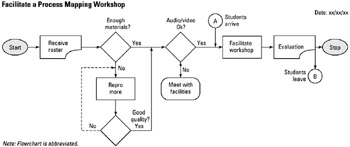Tool 194: Symbolic Flowchart
| AKA | Flow Methods Diagram |
| Classification | Analyzing/Treding (AT) |
Tool description
The symbolic flowchart is a useful problem-solving tool for teams in that it visually describes a sequence of specified steps in a work activity. Using a set of standard symbols for certain types of taks, the flowchart helps to understand the current process and provides the team with insight for the redesign or improvement of the process.
Typical application
-
To analyze basic segments of work, movement of material, and information, and to check if work cells are placed in the most logical place.
-
To ensure the understanding of a process by all participants of a problem-solving team.
-
To verify work sequence and flow in order to simplify work.
-
To reveal no longer needed activities, bottlenecks, redundant tasks, and unnecessarily complex procedures.
Problem-solving phase
| → | Select and define problem or opportunity |
| → | Identify and analyze causes or potential change |
| → | Develop and plan possible solutions or change |
| → | Implement and evaluate solution or change |
| Measure and report solution or change results | |
| Recognize and reward team efforts |
Typically used by
| Research/statistics | |
| Creativity/innovation | |
| 3 | Engineering |
| 2 | Project management |
| 4 | Manufacturing |
| Marketing/sales | |
| Administration/documentation | |
| 5 | Servicing/support |
| Customer/quality metrics | |
| 1 | Change management |
before
-
Systems Analysis Diagram
-
Process Mapping
-
Process Flowchart
-
Work Flow Analysis (WFA)
-
Process Analysis
after
-
Facility Layout Diagram
-
Activity analysis
-
Cycle Time Flowchart
-
Value/non-Value-Added Cycle Time
-
Action Plan
Notes and key points
-
Standard symbols:

-
A flowchart is drawn from top to bottom and reflects left to right directionality. Avoid crossing flow lines within the chart; use connectors within and from page to page.
Step-by-step procedure
-
STEP 1 The team facilitator assembles a team of participants who have knowledge of the overall proces selected to be flowcharted. See example Facilitate a Process-Mapping Workshop.
-
STEP 2 Participants determine the process start and stop points. Additional discussion should determine the level of detail to be shown.
-
STEP 3 Next, all major activities and other steps are identified and associated with a standard set of symbols. Symbols and connecting flow lines are used to show process activity and sequence.
-
STEP 4 The facilitator draws the flowchart on a whiteboard, makes changes, and then continues until the team decides that the complete process has been flowcharted.
-
STEP 5 Finally, the flowchart is checked by the participants for completeness and to ensure that all symbols are sequenced and interconnected correctly.
-
STEP 6 The symbolic flowchart is dated and saved for future reference.
Example of tool application
Facilitate a Process Mapping Workshop

EAN: 2147483647
Pages: 326